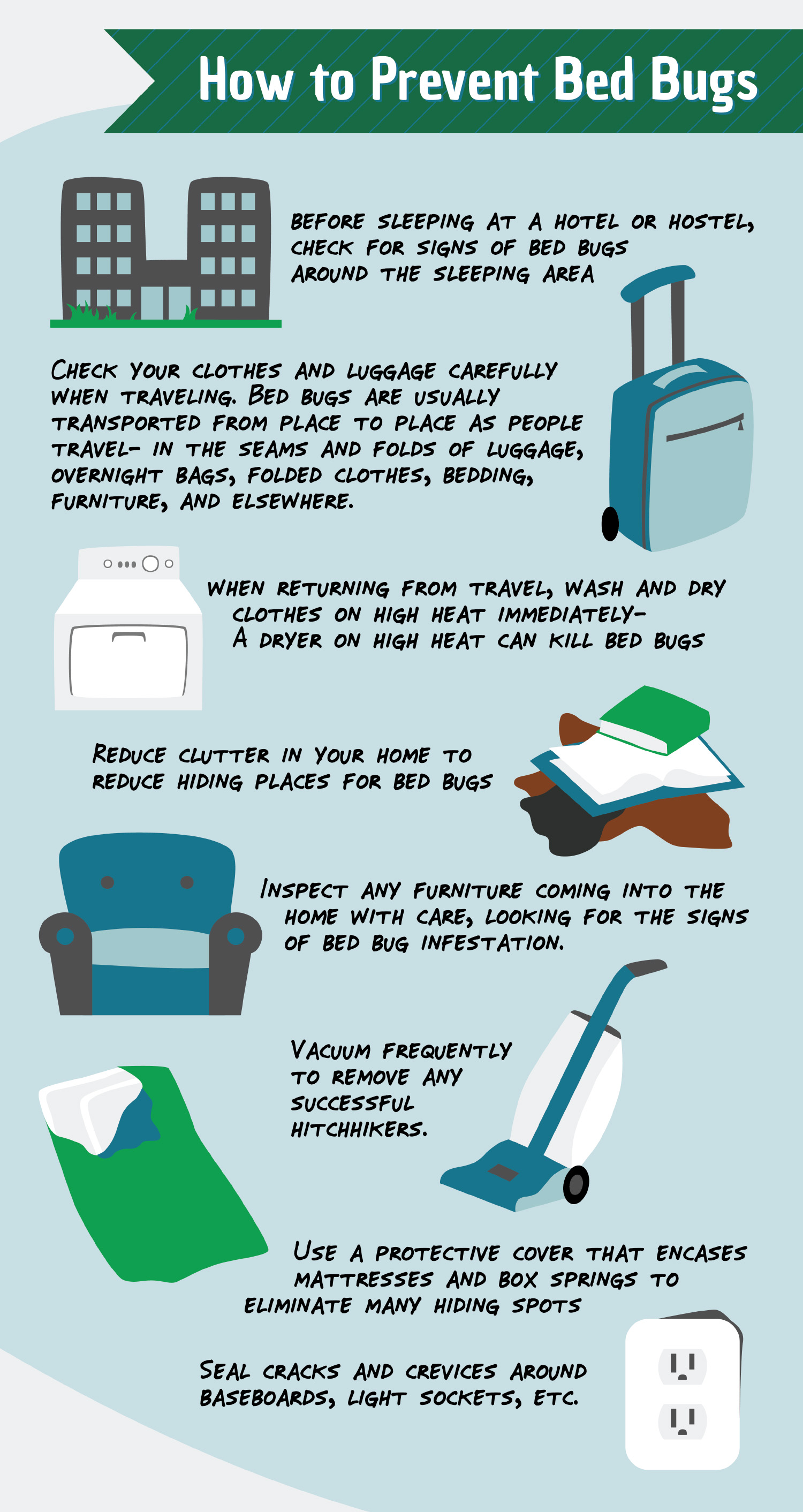

Prevention
Familiarity of this blood feeding parasite’s behavior and appearance is crucial to identifying and preventing them. Bed bugs are nocturnal, being most active when we sleep. They inject a mild anesthetic into a person’s skin and suck a small amount of blood for approximately 3-5 minutes. The majority of people don’t even feel the bite. After bed bugs feed, they retreat to a dark hiding area to digest their meal and lay eggs. Although bed bugs tend to feed on their host every 5 to 10 days; they can survive over a year without feeding. So even if a residence is not occupied for a long period of time, bed bugs can remain alive. Bed bugs are most frequently found in bedrooms, yet infestations can be spread throughout living rooms, laundry rooms, and bathrooms. Inside the bedroom, they are commonly found in mattresses and bedding. They are also found in flooring, walls, furniture, drapery, electrical outlets, ceiling and wall fixtures, and even electronics. Although they are wingless, they are able to move swiftly on both horizontal and vertical surfaces. Bed bugs have, in fact, been known to travel up to 30 feet in one night. Remember, bed bugs do not actually live on humans. They can, however, travel wherever the human goes, “hitchhiking” in or on their clothing, luggage, backpack, and electronic devices; all of which they are capable of penetrating. This ability to travel on numerous different items and at a fairly rapid speed puts everyone at risk.
The appearance of bed bugs varies depending on their maturity level. The nits, which are 1mm sticky pearly white eggs, are nearly impossible to spot with the human eye. The next stage of the bug is the nymph (immature adult). It is more translucent than the adult. Yet if the nymph has recently fed, it can appear bright red in color. Adult bugs are the easiest to spot, having a reddish-brown, oval body. They’re flat and approximately 4-5mm long and 1.5mm wide.
When doing a bed bug inspection there are other signs, aside from the actual bug, you need to look for on the sheets, pillowcases, mattresses, and other nearby areas. The first sign is the nymph’s skin (eggshell), which is molted five times before maturity. These will appear light-brown and oval. Also, keep your eye out for bright red stains, which can occur if the blood engorged bed bug is crushed after feeding. Dark-brown blood spots or smears may be found, as well. These are the result of the bug excreting while feeding on its host.


Safeguarding your home from these pesky insects starts with investing in pillow protectors, mattress and box spring encasements, and Climbup Insect Interceptors. The use of these items, along with following simple cleaning and inspection tips, can save you the hassle and inconvenience of an infestation. Once these preventive measures are in place, you can rest assured that your home will be safe from bed bug infestations.
Tips to follow:
- All bedding should be laundered on a regular basis in water that is at least 120 degrees Fahrenheit. Steam cleaning at a high temperature is another option.
- Regular vacuuming of all floors, baseboards, and furniture. Use the brush and crevice tools to ensure all hiding places are cleaned. Make sure to dispose of the vacuum bag properly. It’s also important to keep the vacuum itself clean, so you’re not creating a new home for the bed bugs.
- Thoroughly inspecting any second hand furniture that is purchased. Avoid bringing used mattresses into your home. Second hand clothing and drapery should also be immediately inspected and laundered at high temperatures.
- Reducing clutter helps to decrease the number of hiding places for bed bugs.
- Open drapes and windows to let the sunshine and air into your home. Bed bugs do not like light or fresh air.
- Keep pets off beds. Dogs and cats are bed bug attractors. Your pets should have their own bed, which is frequently aired out and vacuumed.
- Use box spring & mattress encasements. These will eliminate hiding spots. The encasement’s light color will also enable you see bed bugs easier. Make sure the encasements are specifically designed for bed bugs.
- Invest in pillow protectors.
- Purchase Climbup Insect Interceptors. These are inexpensive, yet valuable, protection aids. These devices, which are placed on the leg of each bed, prevent another path which the bugs are able to travel to reach their host.
- Invest in Bug Domes. These small, low profile monitors/traps use a heating element to attract bed bugs. They are also coated with a special glue to hold any caught bed bugs and insects for inspection. Due to their small size, they are easily placed under a bed or nightstand.
- Use CO2 Monitors for around-the-clock monitoring.
- Use of a Nightwatch Bed Bug monitor. Its new technology attracts and traps bed bugs.
- Isolate the bed from the wall and nightstands. Do not allow any bedding to touch the floor.
Taking proactive measures will not only prevent bed bug infestation, but will provide you peace of mind in knowing that you are “BED BUG FREE”.

Whether you’re an occasional or frequent traveler, steps should be taken to prevent bringing home any unwanted guests. Minimizing your risk of bed bug infestation can easily be done by investing in pillow protectors, a mattress cover, luggage and clothing encasements, and disposable laundry bags. Using these, along with following simple inspection tips, will prevent you from infesting your home when you return from your travels.
Tips to follow:
- Pull all bedding back from the mattress. Inspect for bed bugs, light-brown molted skins, dark-brown markings from defecation while feeding, and bright red stains from a blood engorged bug that has been crushed.
- Be thorough in your inspection, including all edges and seams of the box springs, mattress, and bedding.
- Examine all wood and upholstered furniture, paying close attention to areas around any tufts or buttons on the fabric.
- Purchase both pillow protectors and bed bug mattress covers. These items should be taken with you anytime you’re going for an overnight stay away from home.
- Use luggage racks when packing or unpacking rather than setting your luggage on the floor, bed or upholstered chair.
- Use luggage and clothing encasements. They protect your luggage and belongings from bed bugs while traveling.
- Use dissolvable laundry bags for any bedding or clothing that may have come in contact with bed bugs.
- After returning home, undress on a hard surface floor rather than on carpet if you suspect bed bugs are on your clothing.
- Hand wash items that are unable to be put into the washing machine. Luggage and items that are unable to be washed should be vacuumed, paying close attention to any seams or folds.
Remember, it is much easier and less expensive to prevent bed bugs versus treat for them. These bothersome pests can not only be a nuisance to you and your family, but an embarrassment as well. Take proactive measure by investing in mattress and box springs encasements, mattress covers, pillow protectors, Climbup insect interceptors, luggage and clothing encasements, and dissolvable laundry bags. This, along with following simple cleaning and inspection tips, will save you from an infestation of these rapidly spreading pests. It is imperative to increase public awareness before we see a further rise in the bed bug population.
Taking proactive measures will not only prevent bed bug infestation, but will provide you peace of mind in knowing that you are “BED BUG FREE”.
